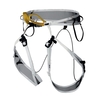The hidden melting of the Gorner glacier (Monte Rosa)

 1 / 5
1 / 5 Alessio Romeo / Inside the Glaciers Project
Alessio Romeo / Inside the Glaciers Project
We live in an interglacial period, ie, a historical period set between two glaciations that began at the end of the last glacial periord or rather the "little glaciation" that ended in 1860, but we do not know when the next one will be... given the increase in average annual temperatures on our planet, it is conceivable that it is still very far away and not in 2030 as scientists have hypothesized.
The current climate change is anything but natural and this exponential increase in temperatures, year after year, is "slowly" depriving us of an extremely important and fascinating natural element: ice. For this we can thank modern times, the economy, man and politics.
We at the Association "La Venta-Esplorazioni Geografiche" have been exploring and monitoring glaciers and the caves that form within the ice for over 3 decades, using them as doors to observe and study the physics, hydrology and more only of these solid water giants directly from their inside.
We have monitored many glaciers, not only in the Alps, but also in other areas of the planet and over the years we have seen them shrink in size and thickness ... well it is no secret, except for a few skeptics, the cryosphere is shrinking, melting and sublimating and therefore essentially disappearing, and with it goes a part of the landscape, history and science. This year we decided to continue a project we'd started in 2020.
In August 2020, right on the Gorner glacier, we noticed some cavities: caves formed within the ice right above the rocky base. They form in two ways. Firstly when a stream, originating from the sides of the mountain, meets the ice; the temperature of the water is above zero and this melts the ice as it runs downwards into the ice mass. And secondly they form at the glacier front, where water often originates on the glacier's surface and enters a moulin. The waters of networks of lateral streams flow under the ice and exit as a single river at the glacier's snout, creating huge and spectacular caves in the ice and then continue towards the valley.
In August 2024 we returned to the Gorner glacier (on the Swiss side of Monte Rosa) where in 2020 we'd begun to monitor a particular cave. In October 2022 we discovered that this natural wonder was connected to other spectacular and even larger caves, and that together they formed a complex network of cavities almost one kilometer long, that descended below the glacier for 190 meters.
We ddin't return in 2023, while this year we decided that it was time to take another look (we were simply too curious!). Above all, we wanted to continue our monitoring, started 2 years earlier, and therefore position temperature sensors to integrate and define our research.
As soon as we arrived on the glacier, considerably different and smaller than 22 months ago, we set up camp in the usual area above the central moraine and headed towards the entrances of this giant cave. Unfortunately however we realised that the glacier was no longer there, or at least, that large area below which the largest and most spectacular caves we now nothing but scree. We were disconcerted but above all crestfallen as we remembered those caves below the blue-hued vault... gone was the vibrant, sparkling ice ceiling, replaced by the uniform sky.
We have been observing the Gorner glacier for many years now and we have come to understand that there is not only superficial melting, the can be observed from home, comfortably seated by comparing satellite images, but that there is also another, equally significant, melting process just below the surface and which we have dubbed: "hidden melting".
It is precisely these streams that plunge down and dig wonderful tunnels that accelerate the disappearance of considerable masses of ice in a short time: the ceilings become thinner, the surface of the river beds widen, the vault collapses and in a flash the ice is gone.
We are, I repeat, aware that we are losing them and that the process of mass retreat, especially on the smaller tongues like these Gorner remnants, is subject to a faster disappearance than the larger tongues. Precisely for this reason, in some situations like this one, we can no longer use the term "slowl" because it seemed to us that this part of Gorner disappeared extremely quickly indeed, leaving us in deep sadness because something beautiful and fascinating is no longer part of our planet Earth. Forever.
Alessio Romeo - La Venta Esplorazioni Geografiche
Info: www.laventa.it



 Copia link
Copia link


























